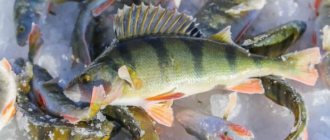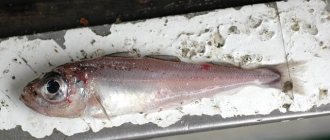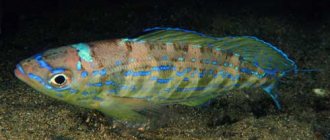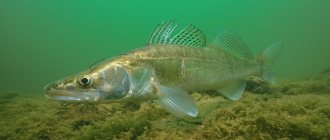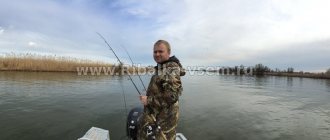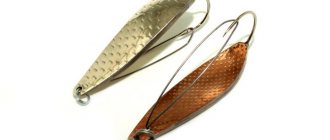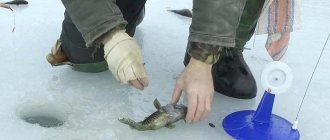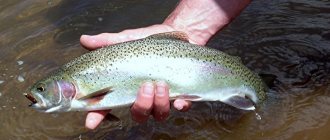| Class | Ray-finned |
| Squad | Gobiiformes |
| Family | Single-tube |
| Genus | Firebrands |
| View | Rotan |
| Security status | Trash fish |
| The average size | 7 cm, 350-400 g |
| Lifespan | 5-7 years |
| What does it eat? | Eggs, tadpoles, small fish, larvae, small amphibians |
| Optimal feeding time | Morning day Evening |
| Enemies | Perch, pike, catfish |
| What do they bite on? | Maliki, small fish, minced fish |
Rotan stands out for its special appearance. The large mouth with numerous small teeth arranged in several rows inspires fear. The species is considered a parasite and destroys large numbers of small fish.
In small bodies of water it can significantly reduce the number of other species. People call the predator a pensioner, a round log, a toad, a crabbill, a grassweed, a wrasse and other similar names. The most commonly used are rotan, ratan and firebrand.
Origin of the species and description
Initially, the rotan fish lived on the Amur, and later appeared in freshwater reservoirs with fresh water. The exact origin is unknown; there are guesses about the distribution of the predator. Initially it was an aquarium fish brought from India. She is very beautiful and unpretentious; she reproduced well in an aquarium with minimal equipment. They called it the Amur bull.
Aquarists decided to conduct an experiment to determine the degree of survival of the species, and released some of the firebrands into a pond near Moscow. The individuals overwintered well and took over the reservoir. Later they began to expand their range, choosing wetlands with standing water.
Spread throughout the Moscow and Leningrad regions. Gradually, rotan fish populated the rivers of European countries and fresh water bodies of Russia. It is widespread in the Far East.
The fish was called firebrand because of its structural features. The third part of the body is occupied by the head. The mouth is large with sharp teeth that are periodically renewed. Small eyes look forward. Acute vision allows you to quickly respond to prey. Outwardly similar to a goby, but belongs to the firebrand family. Fishermen who do not know what rotan looks like consider it a river goby.
In what bodies of water is it found?
The river rotan fish can live in a swamp, and in a roadside ditch, even in a puddle on the road itself. There, the big-headed creature feels even better than in running water.
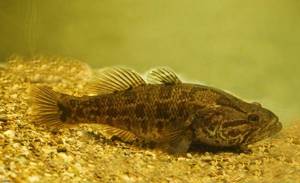
Firstly, stagnant bodies of water have a higher temperature, and rotans love warmth. Secondly, in the swamps and puddles the hero of the article has no competitors. In the rivers there are larger predators, ready to profit from rotan. Therefore, flowing reservoirs are preferred by large species of big-headed creatures that can withstand the onslaught of other predators.
Initially, rotan lived in the Amur basin in China. Since the river also flows through Russian lands, the fish entered them. Then rotan ended up in Lake Baikal. From there the hero of the article was brought to St. Petersburg.
The unpretentiousness of the animal also played a role here. Not every fish will survive such a long journey; at the beginning of the 20th century, the speed of movement around the country and means of transport were different.
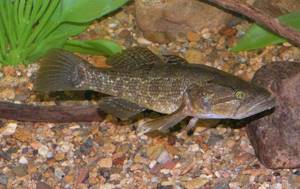
Rotan is considered a trash fish
Rotan loves dark, muddy ponds. Fish survive where even crucian carp die. People say that rotan lives where it is released. After the reservoirs of St. Petersburg, by the way, the hero of the article was released to Moscow. This is again the work of aquarists.
They brought small and unpretentious fish to sell at the capital's poultry market. Making impulse purchases, Muscovites often released their pets into the wild. Rotans cost pennies. Therefore, having grabbed the fish from the hands of the sellers, many only later realized that they did not want to care for the animal.
The situation is especially typical for children who beg for a pet, but are not ready to bear responsibility for it.
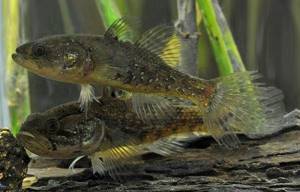
If there is silt in the reservoir, the rotan released into the wild will survive. Burrowing into the viscous bottom, the fish successfully exists in almost completely frozen rivers and ponds. The hero of the article also survives in reservoirs that dry up during periods of summer heat. The same silt saves. Burrowing into it, the fish finds the necessary amount of moisture and oxygen.
Appearance and features
The body is dense and slightly shortened. The scales do not shine. Color shades vary. The color depends on the light and the color of the bottom of the reservoir in which they live. Gray-green and dirty brown shades are more common. Pattern in the form of stripes and spots of various shapes. The abdomen is gray. During spawning, the body of males turns black, so those who do not know what rotan looks like consider it a different type of fish.

The gill covers have a soft spine turned backwards. The fins are tinted to match the body color and are transparent. The hind ones are longer than the front ones. The caudal and pectoral fins have a rounded shape. The abdominal ones are very small, paired, located next to the head.
The maximum size of an individual is 14-25 cm, but the firebrand rarely reaches this length. The average life span is 4-5 years, but in good conditions it lives up to 7 years. Weight 350-400 g. The fish are very hardy. They can withstand freezing of the pond to the bottom, their partial drying out, lack of oxygen, turbidity and water pollution.
The largest in the world
Fishermen love to tell stories about huge fish of different species that they “caught in the old days.” Rotan also began to appear more and more often in stories, despite the fact that, according to ichthyologists, the maximum weight of an adult is 400 g. And yet on fishermen’s forums there are stories about 800-1000 gram rotans with a huge mouth and sharp teeth ready to bite the hand of a gaping fisherman. True, all these stories are not accompanied by photographs or other documentary evidence. The largest rotan that was captured in the photo was 550 g, according to its catcher.
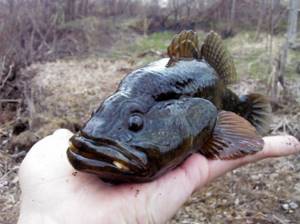
Where does rotan live?
It is unpretentious in terms of living and feeding conditions, but prefers floodplains with rich vegetation, oxbow lakes, and ponds with stagnant water. He treats the current with caution, tries not to swim close and avoids it.
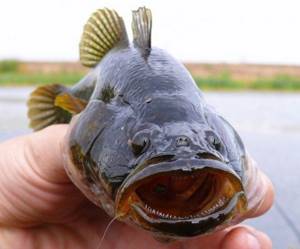
Initially, the species was recorded in the Far East of the Russian Federation, northeastern China, the Amur basin, and northern North Korea. Later he populated Baikal and the reservoirs of St. Petersburg, where he was deliberately released.
Now the firebrand is observed in Northern Eurasia, the basins of the Danube, Dnieper, Volga, Don, Dniester rivers, and in most water bodies of Russia. Waterfowl contribute to the expansion of the population. They carry eggs stuck to their paws over long distances.
See what “rotan” is in other dictionaries:
- - (firebrand) fish of the order Perciformes. Length up to 25 cm. In the Amur basin and rivers of Primorye. Introduced (accidentally) into some water bodies of the European part of Russia and Middle East. Asia. Sport fishing object ... Big Encyclopedic Dictionary
Firebrand (Perccottus glehni), fish of the family. firebrands (E1eotridae) neg. perciformes. Dl. 8 14 (up to 25) cm. In breeding plumage, R. is almost black (hence the 2nd name). Lives in bass. Amur, accidentally brought to Europe. part of the USSR, where quickly ... ... Biological encyclopedic dictionary
Noun, number of synonyms: 7 firebrand (7) bawler (26) bawler (10) ... Dictionary of synonyms
Jan Philipp Roothaan Jan Philipp Roothaan (Dutch. Jan Philipp Roothaan, (November 23, 1785 May 8, 1853) general of the Society of Jesus (Jesuits), twenty-first head of the order and third after its restoration in 1814. Jan Rothan ... Wikipedia
rotan - nuodėgulinis grundalas statusas T sritis zoologija | vardynas taksono rangas rūšis atitikmenys: lot. Percottus glehni engl. Amur sleeper rus. firebrand; rotan firebrand; rotan ryšiai: platesnis terminas – nuodėguliniai grundalai … Žuvų pavadinimų žodynas
- (firebrand), fish of the order Perciformes. Length up to 25 cm. Lives in the Amur basin and rivers of Primorye. Introduced (accidentally) into some water bodies of the European part of Russia and Central Asia. Sport fishing facility. * * * ROTAN ROTAN (firebrand (see... ... Encyclopedic Dictionary
Fill up the rotan. Jarg. they say Rough Shut up. Vakhitov 2003, 57 ... Large dictionary of Russian sayings
Fish of the firebrand family; the same as firebrand (See firebrand) ... Great Soviet Encyclopedia
— (Georg Rothan, 1822 1890) French diplomat and writer; was secretary of the embassy in Frankfurt am Main, Berlin and Brussels, consul general in Frankfurt am Main, charge d'affaires to the Hanseatic cities, envoy to the Italian... ... Encyclopedic Dictionary F.A. Brockhaus and I.A. Ephron
- (firebrand), fish of the order Perciformes. Dl. up to 25 cm. Lives in bass. Amur and rivers of Primorye. Introduced (accidentally) into some water bodies in Europe. parts of Russia and Middle Asia. Sports object. fish wa... Natural history. encyclopedic Dictionary
What does rotan eat?
Tadpoles eat zooplankton. Grown-up babies consume benthos and invertebrates. Adults eat juveniles, amphibian tadpoles, insect larvae, newts and small fish. They are capable of eating small firebrands and their own fry; cannibalism is widespread. In small bodies of water, rotan fish reproduce well and destroy other species of fish.
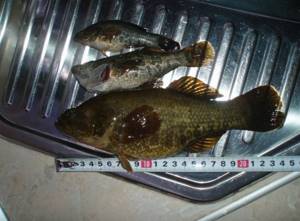
Interesting!
Scientists call rotan a pest, as it adapts perfectly to any fresh body of water. It quickly destroys populations of other fish species in the area if there are no large predators in the habitat.
She is very gluttonous. Does not neglect leeches, earthworms, eggs and insects. It can consume minced meat, swallowing the bait deeply. He eats a large amount of food at one time, so his stomach increases 3 times. During the day it can eat 2-3 fish up to 4 cm long. It is easy to catch rotan with an ordinary fishing rod, stringing pieces of lard or raw meat onto a hook.
Rotan is a small and dangerous predator
There are 3 types of rotans in total, but only one is common in Russia - grass or firebrand, aquarists call it the Amur goby. Do not confuse rotan with rattan - these are different types of fish. Rotan is the only representative of the firebrand genus and belongs to the ray-finned species. Despite its modest size, it is an active predator that can pose threats to fisheries as it eats the fry of valuable fish. However, many fishermen use it as bait for large predators; rotan is no less popular in cooking.

Features of character and lifestyle
Rotan is not picky about water temperature. It feels great in water at a temperature of +3⁰ - +40⁰. Allowed to be kept in an aquarium. For full development, 10 liters of water per individual is required. In an artificial environment, fish have brighter colors due to better lighting. It is recommended to provide plenty of cover and vegetation.
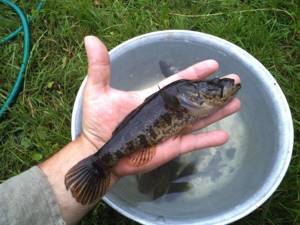
During the hunt, it floats unnoticed in the water, approaching the prey. When about 10 cm remains to the target, the predator makes a dash and swallows the prey without missing a beat. The victim does not have time to escape from him because he does not notice in a timely manner. The herb prefers dense thickets, which makes catching difficult. Gear easily gets tangled in mud and snags.
You can fish with a float rod and spinning rod at any depth, including in shallow water where the bottom is clearly visible. The predator is difficult to spot. Its presence can be determined by the shadow cast on the bottom.

If natural bait is not provided, artificial lures resembling worms and fry are thrown. It is recommended to choose bait made of edible rubber, since fish, when hunting, rely on the taste of their prey.
How to catch Rotan
Rotan is not visually attractive, but despite this, the fishing process is exciting. The fish does not react to things that happen on the shore. It pounces on the bait greedily. You can pull it out of the water using regular float gear. The bait should be used exclusively live, it should smell delicious and behave actively in the water. If there is no reaction within 15–20 minutes, this means that it is better to put on a new bait.
We also recommend that you read the article: features of catching rotan in October.
When sport fishing, be sure to keep an extractor handy. Needed to remove the predator from the hook. Like a shark, rotan completely swallows the bait, so if you remove it carelessly, you can damage the internal parts of the fish, which is contrary to the principle of sport fishing.
To learn more:
Gudgeon: description of fish, habits and methods of fishing
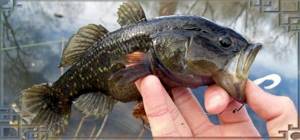
Spinning fishing involves the use of silicone baits. It is better to choose colorful options to attract fish. Rotan reacts equally to bait on the bottom or on the surface. The predator instinct works the same way. However, closer to the bottom the reaction slows down, because the firebrand is very lazy. Therefore, it is recommended to cast the bait closer to the surface, which causes adrenaline not only in the bait, but also in the catcher.
Advice! To increase the likelihood of a catch, use a hook on a red thread. This way the predator will be more interested in the bait.
Rotan as bait
This small predator attracts not only as a trophy. Using this bait you can catch an excellent catch in the form of pike or pike perch.
Advantages of rotan as bait:
- Easy to catch. Even in the cold season, it is not difficult to catch a predator in a pond. It is enough to throw the bait, and the thirst for profit will do everything itself.
- Glibness . One bait can help you catch several big trophies. If a pike or pike perch bites through the scales of a rotan, the fish will still remain tenacious and will also actively move in the water.
- Range . With this fish you can catch many different species that live in the reservoir.
Social structure and reproduction
Two-year-old individuals are ready to breed. Mothers that have reached a length of 7 cm are capable of spawning. The firebrand spawns in May-June, choosing places with high vegetation. In males, the upper part of the head swells and the body turns black. One large female lays from 100 to 1 thousand eggs.
The masonry is attached to various objects and plants independently. The eggs are sticky, stick well, and can settle to the bottom, attaching to household waste that has settled at the bottom.
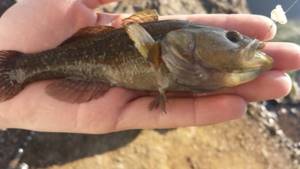
The male guards the eggs until the tadpoles develop. Then he changes his attitude towards the offspring, they become a target for hunting. To survive, tadpoles are forced to hide in algae and among various objects at the bottom. The fry eat only food of animal origin; as the individual grows, the size of the prey increases.
Keeping in an aquarium
Lovers of original pets have long learned to breed rotan in an aquarium. This does not require any special skills, the main thing is to feed it correctly so that it does not eat other inhabitants of the home “reservoir”. According to aquarists, this “monster” is capable of swallowing up to a dozen female guppies in a few days. For this reason, they try to keep rotans in a separate aquarium.
Firebrands eat everything that is protein food of animal origin:
- worms, flies, moths;
- larvae and bloodworms;
- pieces of frozen fish;
- minced meat or fish.
Even not very careful aquarists can take care of firebrands, since these fish:
- do not need frequent cleaning of the aquarium, the water can not be changed for more than 2 weeks;
- do not suffer from a lack of oxygen, aeration of the aquarium is practically not needed;
- tolerant to changes in temperature of water and ambient air.
Both at 0 and at 400, rotan feels great, grows well and reproduces in captivity. Aquarium rotans differ from those found in nature by the golden color of their scales. Only in males it darkens slightly on the eve of the mating season.
Watching these active fish is quite interesting. Although many call them lazy, they constantly fight for territory and start fights among themselves.
The only thing that can happen to a careless rotan owner in an aquarium is attacks of cannibalism if they are not fed on time. In the absence of food, large individuals will certainly eat smaller ones.
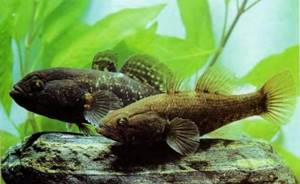
Population and species status
The rotan fish is considered a weed, as it reproduces very quickly and displaces other fish, including valuable species. In some reservoirs the status “Biological pollution by rotan” has been assigned. A decision was made to artificially reduce its population by catching adult fish in areas of excessive distribution in order to enable valuable species to restore their numbers.
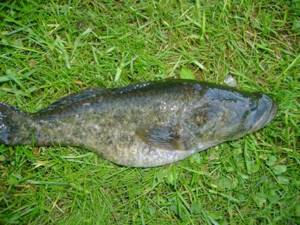
My “acquaintance” with rotan.
One summer, some time ago, my friend and I went to sit with fishing rods on a small lake, 50 kilometers from the city. We settled down in our favorite place, in the bushes. They began to slowly pull out perch, chebak, and small crucian carp. We went fishing, and almost before leaving home, I loaded the worm for the last time. While I was packing my things, I didn’t pay attention to the fishing rod.
Turning around, I saw a bite, it was biting so quickly. Hook - and, hurray, the fish is on the shore. How surprised my friend and I were at my catch! The bait caught some kind of big-headed and big-mouthed black fish, with a mouth full of sharp teeth, unusual dorsal fins - one high, the other long.
The fish was fifteen centimeters long, weighing 150 - 200 grams. Before this incident, neither I nor my friend had ever seen such a miracle.
Is this a predatory fish?
The rotan fish does not attack large specimens, so it is difficult to call it a classic predator that destroys everything. The number of crucian carp, carp and other fish is reduced due to the consumption of caviar and fry.
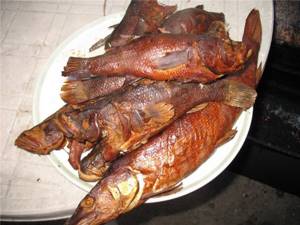
The herb brings benefits and harm at the same time. It is an active predator of small fish and can destroy the entire species in its habitat. The number of individuals in the reservoir decreases, the surviving fish receive more nutrition and grow larger.
Taste properties of rotan, can it be eaten?
Many people are interested in whether the herb is edible or not. It is valued by chefs for its dietary meat. It is stewed, fried, boiled and dried. There are practically no bones in the carcass; it is easy to clean from scales. The giblets are removed by making an incision in the abdomen along the head. Fried meat turns out sweetish.
Important!
Bones are usually removed during eating. It is not advisable to clean a small carcass from bones.
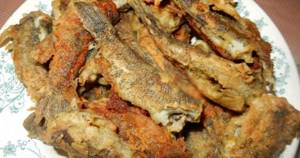
Boiled meat has a white-pink color and a delicate taste. There are very few large bones, so the fish is perfect for stews and canned food. Dietary meat is well digestible. 100 g contains 88 calories. Fish contains a lot of protein, vitamins A, E and D, as well as bromine, iron, copper, manganese, potassium and magnesium.
Benefits and harms
Among fishing enthusiasts, there is ongoing debate around the potential harm and benefits of rotan fish. Some consider it a truly “weedy” inhabitant of fresh water bodies, displacing more valuable species or reducing their numbers. For pond farming, rotan clearly appears to be an enemy that can cause harm to fisheries and huge losses to pond owners.
Others justify rotan, saying that with proper management of fisheries, it is possible not only to preserve populations of valuable fish in its presence, but also to improve their condition. According to the observations of experienced fishermen, in natural ponds where rotan has settled, the populations of other fish are noticeably enlarged. That is, the individuals that survive as a result of natural selection grow to larger sizes than in the absence of such a “nurse” as rotan fish. Rotans get along especially well with crucian carp, since they are not competitors in nutrition: crucian carp feeds on plant foods, and rotan eats small freshwater animals.
This version is followed by connoisseurs of the taste of rotan. Its tender, white-pink meat has a dense structure; when cooked, it separates well from large bones, which are not so abundant in the body of this unusual fish. It tastes like crucian carp. The pulp contains all the macro/microelements and vitamins that river fish is rich in: phosphorus, calcium, potassium, molybdenum, vitamins PP, A, D, E.
Rotan recipes
Fried firebrand. Select large specimens. Gutted carcasses can be cut into pieces, but it is better to fry them whole. The fish is well dredged in flour and fried on both sides until golden brown. Use vegetable or butter. To get a crispy crust, cover the pan with a lid 5 minutes before the end of cooking.
Firebrand omelette. The roasted carcasses are cut into pieces and placed in a frying pan. Beat eggs with milk. The resulting mixture is poured into a frying pan. You can add finely chopped green onions and other greens to it at your own discretion. Prepare in the same way as a traditional omelet with the lid closed.
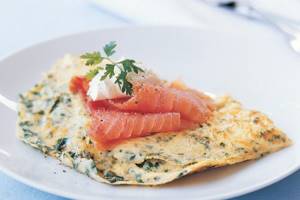
Fish under marinade. The carcasses are boiled in salted water until cooked. Separate the bones by placing the meat pieces in a deep dish. Prepare the marinade. Finely chop the onion, grate 2 carrots. The vegetables are transferred to a frying pan and fried, tomato paste is added to them, about 3-4 spoons, and 1 spoon of vinegar and spices. The fillet is poured with marinade and allowed to brew for several hours. Suitable as a cold snack.
Fish salad with egg and cucumber. The carcasses are boiled or stewed until cooked. Disassemble into pieces, separating the bones, crush with a fork. Add chopped boiled egg and pickled cucumber cut into small cubes to the minced meat. Season with mayonnaise or special dressing. For dressing, take mustard, vegetable oil, a little salt, add pepper as desired.
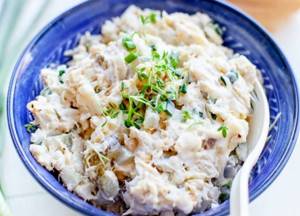
Firebrand soup. Chop the potatoes and carrots into cubes in a saucepan of cold water. It is better to add dried dill and parsley to boiling water instead of fresh herbs. Add bay leaf and black peppercorns. Place the prepared fish pieces into the broth and cook for 20 minutes. You can add butter and sour cream to the finished dish.
Ear. Whole processed carcasses, turnips, carrots, parsley and celery roots, a medium onion, bay leaf, and black pepper are placed in a cauldron with cold water. After boiling, add diced potatoes. Cook for about 60 minutes. The finished dish is sprinkled with finely chopped parsley and dill.
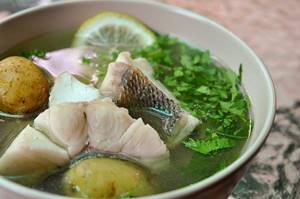
Fish ears. Belarusian dumplings are called ears. Minced fish is prepared from pre-boiled fish. Fry onions. Add 1 cup of boiled mushrooms and onions to the minced meat. Pepper, add salt and mix. The resulting filling is used to fill dumplings.
Baking in the oven. Prepared headless carcasses are rubbed with a small amount of salt. Let them sit until they are salted. Rinse off the salt and dab with a paper towel. Preheat the oven to 200⁰. Pour vegetable oil into a glass baking dish, spreading it over the bottom in a thin layer. Place the fish and cover it with vegetable oil so that the fish does not dry out or burn. Cover with foil and bake for 30-40 minutes. Then remove the foil and bake until golden brown for about 10 minutes.

The firebrand is considered a universal fish. You can prepare almost any dish from it: cutlets, casseroles, canned fish and pies. There are many recipes for experienced cooks and those who do not know how to cook rotan. The fish is combined with a side dish and can be used as an independent holiday dish.
Notes[ | ]
- FishBase: Synonyms of Perccottus glenii
Dybowski, 1877 - Reshetnikov AN, 2010. The current range of Amur sleeper Perccottus glenii
Dybowski, 1877 (Odontobutidae, Pisces) in Eurasia. Russian Journal of Biological Invasions. 1(2): 119-126. - ↑ 1 2 3 4 Reshetnikov Yu. S., Kotlyar A. N., Rass T. S., Shatunovsky M. I.
Five-language dictionary of animal names. Fish. Latin, Russian, English, German, French. / under the general editorship of academician. V. E. Sokolova. - M.: Rus. lang., 1989. - P. 346. - 12,500 copies. — ISBN 5-200-00237-0. - Firebrand // Great Soviet Encyclopedia: [in 30 volumes] / ch. ed. A. M. Prokhorov. — 3rd ed. - M.: Soviet Encyclopedia, 1969-1978.
- Kolyvan dinosaur. Rotan 30 cm, 800 g - photo. (Russian). FishingSib. Date accessed: December 2, 2021.
- Elovenko V.N.
Why rotan does not freeze. - Chemistry and Life, 1981. - No. 1. - P. 30. - ↑ 12
Tsepkin, 1999.
